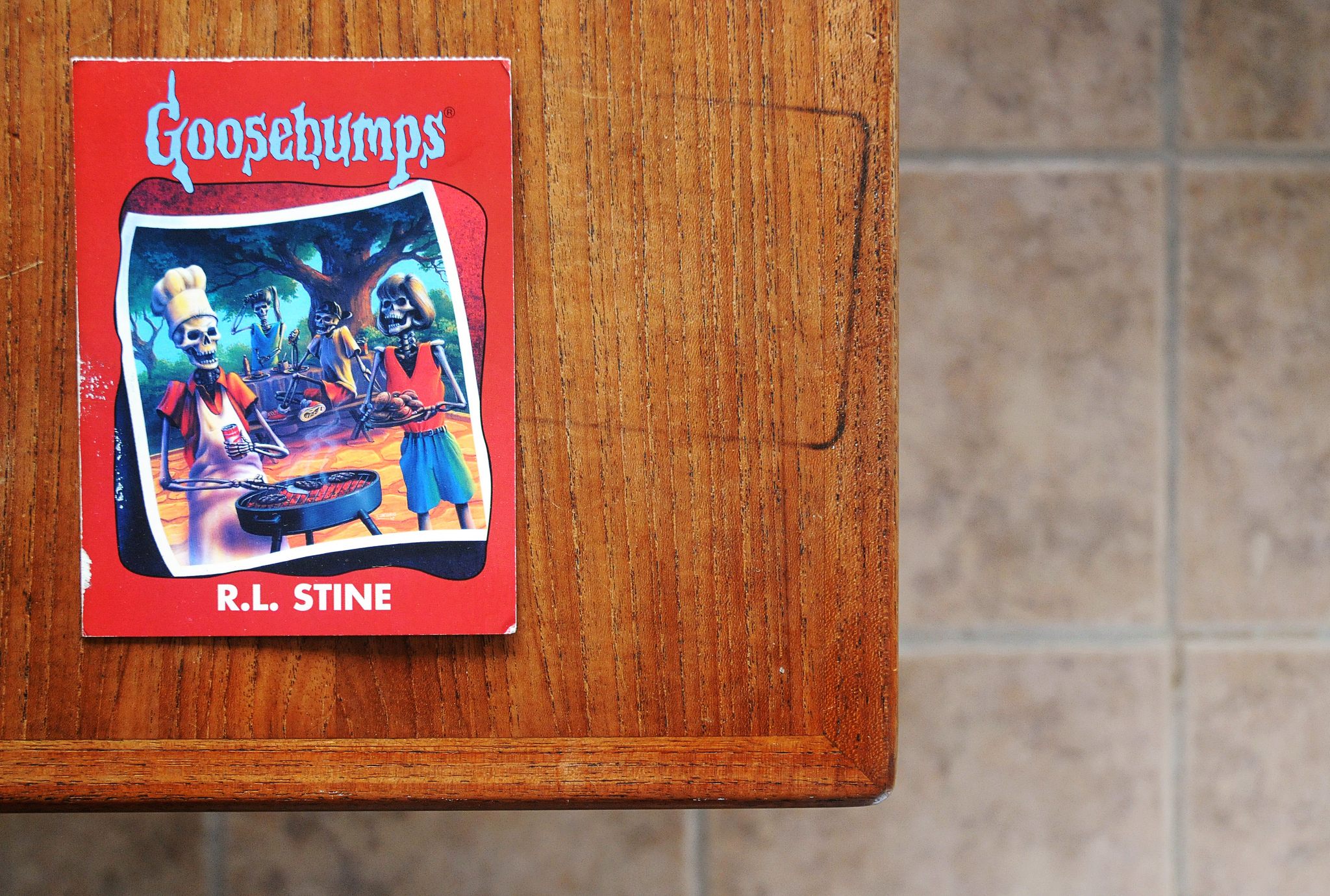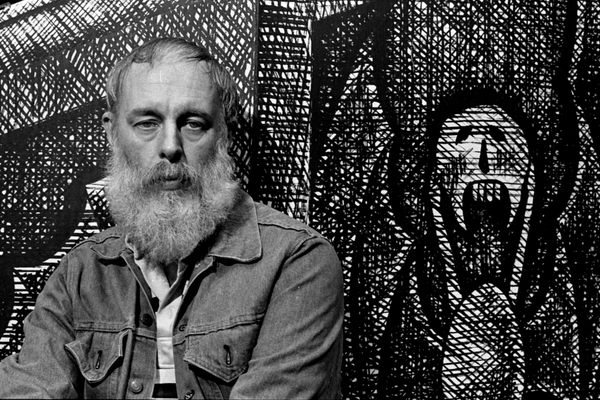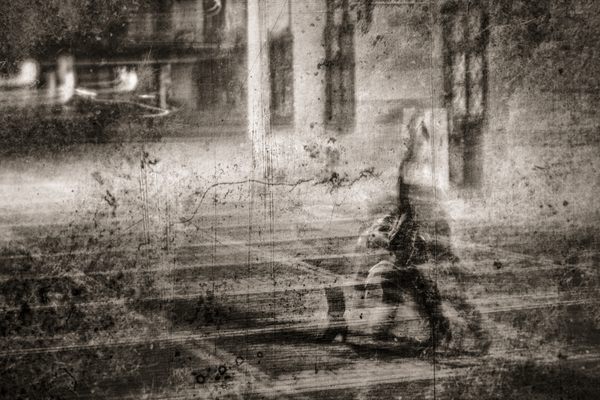R.L. Stine Loved Haunting Your 90s Childhood With ‘Goosebumps’ Books

A Goosebumps postcard (teakwood/Flickr/Creative Commons)
This article originally appeared on Motherboard.
There’s not much that scares R.L. Stine, though he’s had a lot of time to think about it. The prolific children’s author of the Goosebumps and Fear Street franchises has been entertaining kids and pulling them into a world of goofy, spooky, kid-appropriate-but-not-condescending horror for 23 years. In that time he’s been asked dozens of times by reporters what scares him, but he told me he’s never been able to come up with a good answer.
“I really should come up with one,” he said with a chuckle.
Stine recently took a half hour out of his day to chat with me (during the week before a movie based on his books was about to debut, I’ll note). Though we weren’t able to surface any latent fears of clowns or spiders, when we talked about the future and technology, it’s clear Stine, like so many of us, is equal parts fascinated and horrified at the possibilities.
Stine has written over 300 books (nearly half were Goosebumps) and is still writing new volumes, though not at the breakneck pace he did in the 90s when a new Goosebumps book was published every month. A beloved, if campy, television show was made based on his short novels, and now a major motion picture starring Jack Black has premiered. Stine’s works were a cultural touchstone for children of the 90s and he continues to entertain, writing everything from new editions of his teen-focused Fear Street stories to preschool books (he told me this choice was inspired by his grandson).
Here’s the best of my conversation with the kids’ horror master, complete with musings on the 90s, tips about writing, concerns about DNA manipulation, and a revelation about the trouble with cell phones.
How, as a writer, are you able to strike that balance between what’s too scary and will, maybe, upset children and what’s not scary enough?
That is the only hard part about writing horror I think: the line between being boring and being too scary and knowing how to be in the middle of it. If you’re too careful, then they’re not going to be interested. If you go too far, then you’re going to upset the kids. I have one rule and the rule basically is you can go pretty far if the kids know it’s a fantasy, that it can’t happen.
What ever happened as far as Fear Street? There was a long hiatus there and then you sort of rejuvenated it.
I didn’t write any for 20 years and then I was on Twitter and, you know, there are no kids on Twitter. It’s all 20 and 30-somethings who grew up on Goosebumps and Fear Street, and they all were saying ‘why don’t you bring back Fear Street?’ We talked to a few publishers and they weren’t interested.
So one night on Twitter I decided to be really honest and I just said: ‘thank you for your interest in Fear Street but it’s not going to happen because no publisher is interested.’ Ten minutes later I got a tweet from Kat Brzozowski, who’s an editor at St. Martin’s, and she said ‘I loved Fear Street, I would love to publish some Fear Street books.’ And that was it.

Why do you think there was a demand for it to come back?
I think [the books were] a big part of a lot of people’s childhood and teen years. You know, nostalgia. Kaleigh, how would you like to be nostalgia? Right? That took a little adjusting. That was kind of a shock at first, to be nostalgia. Actually, it’s lucky I guess.
What kind of things scare you?
You know all these years, I’ve never had a good answer to that. I have normal adult fears. I have nothing.
What are ‘normal adult fears?’
You know: am I gonna be hit by a car? Is a brick going to fall off a building and hit me in the head? You know, normal things if you live in a city.
Is there any kind of new technology that scares you?
There’s all this new science and we take it for granted. Now they’re talking about getting into the DNA and changing it, which is really interesting and kind of scary at the same time. [A geneticist I met] was saying that it’s too late to be scared of it. But I thought it was really fascinating because it’s something that’s going to happen really quickly and no one really knows how far to go.
As far as technology, we write a lot about virtual reality. Can you see some interesting ways that VR might be able to shape horror storytelling in the future?
The closer you can get to horror, the scarier it’s going to be. If you can get someone inside the scene, that’s going to be pretty terrifying. The scariest way to enjoy horror is reading because it’s all happening right in your head. And if you could do a virtual reality thing, then once again it’s all happening right in your head.
I have some questions here submitted by my colleagues. One is: if you could resurrect any horror writer from the dead, who would it be?
[Laughs] Do you have a list of dead horror writers to choose from? It would have to be Poe, wouldn’t it?
Yes, yes.
I’m just thinking, I read Poe in like junior high, just out of Goosebumps age. That’s when we read it. That’s odd, isn’t it? That we read him so young?
It is. I distinctly remember getting a Poe anthology somewhere around the seventh grade.
Yes! From, like, Half Price Book Club! They had some anthology of Poe stories, with ‘The Black Cat’ and everything.
Yeah, some of those are pretty sinister.
Oh my God. They’re incredible.
I think there’s something, when you’re that age, that is really appealing about that because you’re so morose.
That’s really true, when you’re just starting to be a teenager. Definitely. I have this theory that one of the reasons Goosebumps was so popular is because kids identify with the monsters, not the protagonists. Sometimes kids, especially at that age, feel like monsters. They’re angry. They’re frustrated. They want to roar. They don’t have control and they want to get control. It’s part of the real appeal.
Is Goosebumps still as popular as it was in the 90s?
No, no, not at all. The craze! Are you kidding? I got spoiled. They still do well, I’m still writing four a year. But in ‘93, ‘94, and ‘95, I was the bestselling author in America, adult or children. USA Today has the bestseller list, the top 50, and Goosebumps books would be 20 of the top 50. Kaleigh, we were actually—ah, I don’t want to sound like I’m bragging.
No, no, go on!
We were selling four million books a month. Yeah, those were the days. I loved the 90s.
Do you think kids reading today are different than the audience in the 90s?
The kids are the same, but the technology is all different and they’re probably smarter because of it. But luckily the fears never change: fear of the dark, fear of going down in the basement, fear that there’s something under the stairs. That never changes.
But cell phones are the worst thing for writing horror. Cell phones ruin almost every plot.
Because if they just pull out their phone they can get help?
Exactly. There would be a Fear Street where a girl is getting frightening phone calls. It used to be ‘who could it be?’ Now, she’d just look at her phone and the book is over. They’ve really ruined things.
I’m sure you get this question a lot, but do you have a favorite and/or least favorite of the Goosebumps series?
I have a few least favorites. When you write that many books, there are about 125 of them now, some turn out better than others. I’m very proud of The Haunted Mask. I think that’s a good Halloween story. And I like all of the ones with Slappy the evil dummy that comes to life. For some reason he’s my most popular villain.
A colleague of mine just before I hopped on this call recounted a family vacation she took as a kid and she brought Night of the Living Dummy and was up all night certain that her family was turning into ventriloquist dolls.
[laughs] I don’t really get it. I don’t know why, it’s just a dummy, but I have to keep writing him because people like him.
Are you tired of it at all? Are you getting worn out?
Well, I got old [laughs]. But I still enjoy it. I like getting up in the morning and writing my ten pages. I don’t know why I like it so much. I started when I was nine years old. But, yeah, I still really enjoy it and now it’s more of a challenge since I’ve done every story a human could possibly write. It’s more of a challenge. It’s good to have to think of new scares and new chapter endings. I don’t know, it’s fun. I don’t know what else I’d do all day.
This interview has been edited for length and clarity.
All in Your Head is a series that takes a scientific look at all things spooky and scary. Follow along at Motherboard.












Follow us on Twitter to get the latest on the world's hidden wonders.
Like us on Facebook to get the latest on the world's hidden wonders.
Follow us on Twitter Like us on Facebook